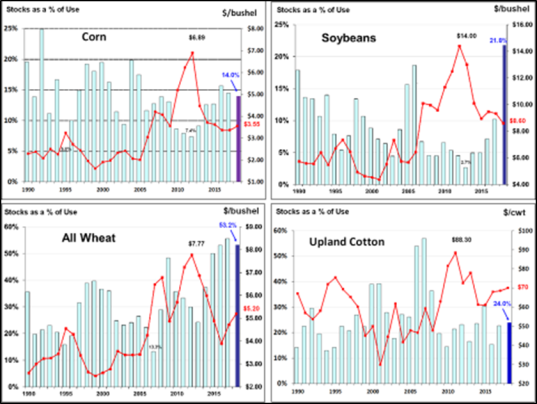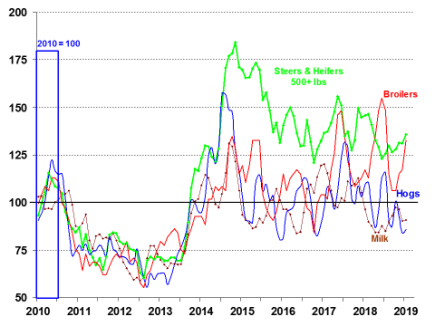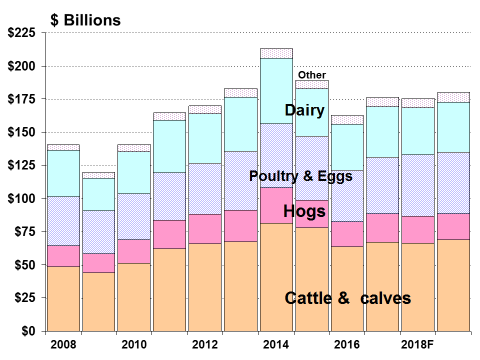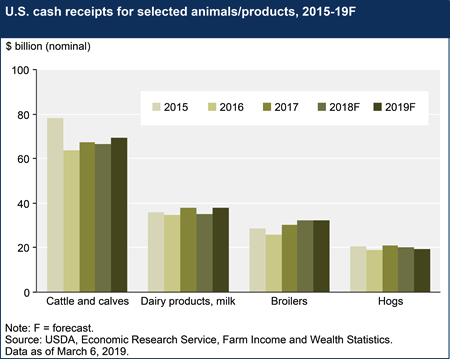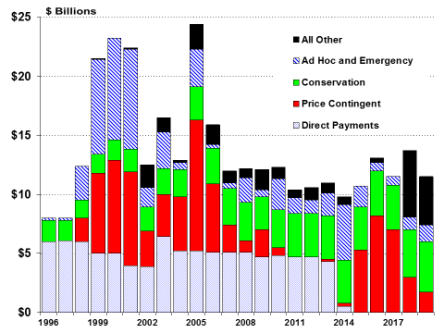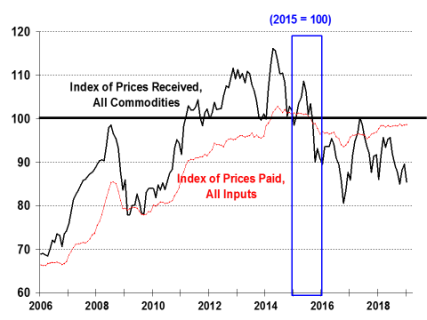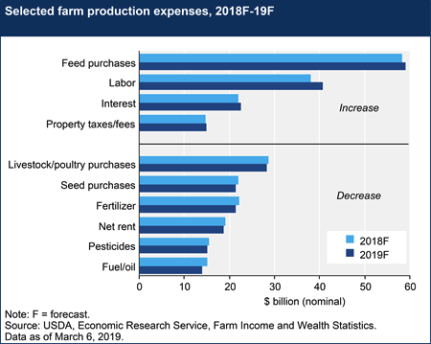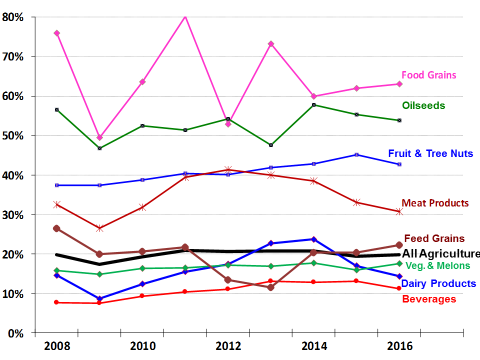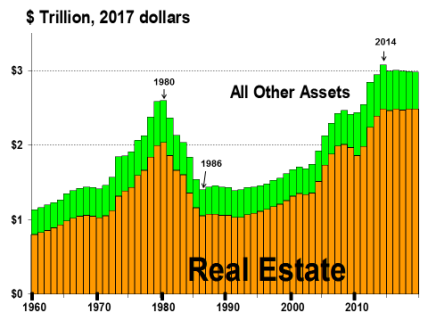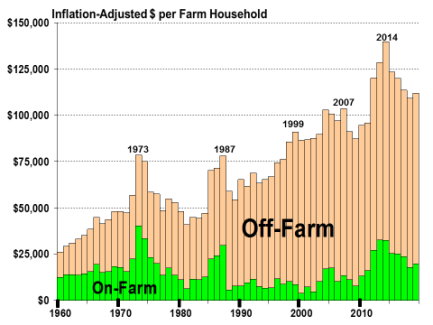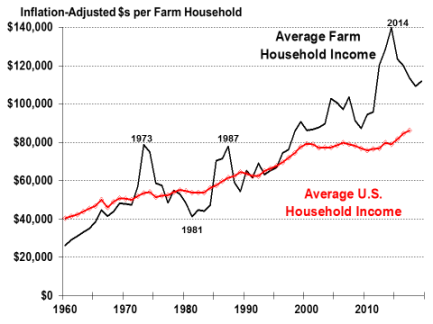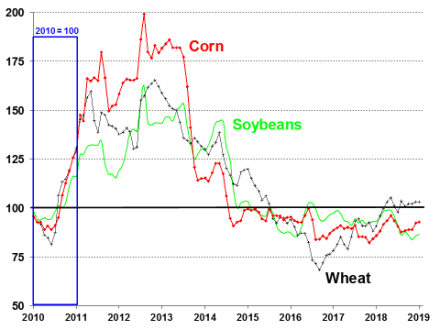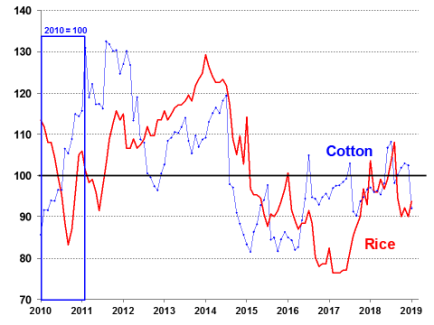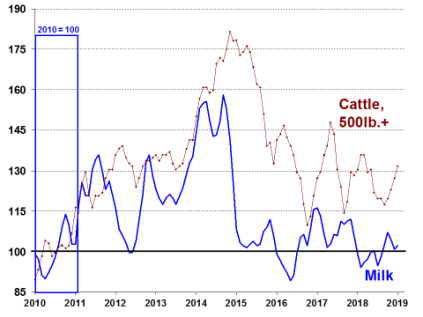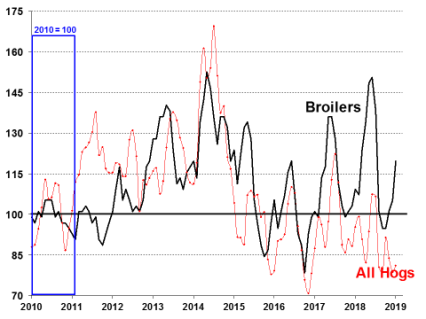U.S. Farm Income Outlook for 2019
This report uses the U.S. Department of Agriculture’s (USDA) farm income projections (as of March 6, 2019) and agricultural trade outlook update (as of February 21, 2019) to describe the U.S. farm economic outlook. According to USDA’s Economic Research Service (ERS), national net farm income—a key indicator of U.S. farm well-being—is forecast at $69.4 billion in 2019, up $6.3 billion (+10%) from last year. The forecast rise in 2019 net farm income is the result of an increase in gross returns (up $8.5 billion or +2%)—including continued payments under the trade aid package announced by USDA in July 2018—partially offset by slightly higher production expenses (up $2.2 billion or +0.6%). Net farm income is calculated on an accrual basis. Net cash income (calculated on a cash-flow basis) is also projected higher in 2019 (+4.7%) to $95.7 billion.
The 2019 net farm income forecast is substantially below (-18%) the 10-year average of $84.8 billion (in nominal dollars)—primarily the result of the outlook for continued weak prices for most major crops. Commodity prices are under pressure from a record soybean and near-record corn harvest in 2018, diminished export prospects due to an ongoing trade dispute with China, and burdensome stocks.
Government payments are projected down nearly 17% from 2018 at $11.5 billion—due largely to lower market facilitation payments by USDA. Market facilitation payments to qualifying agricultural producers—in response to the U.S.-China trade dispute—were an estimated $5.2 billion in 2018 and are projected at $3.5 billion in 2019. Price Loss Coverage (PLC) and Agricultural Risk Coverage (ARC) payments are also projected lower in 2019 ($1.7 billion) versus 2018 ($3.0 billion). Payments to dairy producers under the new Dairy Margin Coverage (DMC) program are projected up over 200% at $600 million, while payments under conservation and disaster assistance are projected up in 2019 at $4.3 billion (+8.6%) and $1.4 billion (+20%).
Since 2008, U.S. agricultural exports have accounted for a 20% share of U.S. farm and manufactured or processed agricultural sales. In 2018 total agricultural exports were estimated up 2% at $143.4 billion. However, abundant supplies in international markets, strong competition from major foreign competitors, and the ongoing U.S.-China trade dispute are expected to shift trade patterns and lower U.S. export prospects slightly (-1%) in 2019.
In addition to the outlook for slightly higher farm income, farm asset value is also projected up 1.5% from 2018 to $3.1 trillion. However, aggregate farm debt is projected record large at $426.7 billion—up 3.9% from 2018. Farm asset values reflect farm investors’ and lenders’ expectations about long-term profitability of farm sector investments. USDA farmland values are projected to rise 1.8% in 2019, similar to the increases of 1.9% in 2018 and 2.3% in 2017. Because they comprise such a significant portion of the U.S. farm sector’s asset base (83%), change in farmland values is a critical barometer of the farm sector’s financial performance. At the farm household level, average farm household incomes have been well above average U.S. household incomes since the late 1990s. However, that advantage has narrowed in recent years. In 2014, the average farm household income (including off-farm income sources) was about 77% higher than the average U.S. household income. In 2017 (the last year with comparable data), that advantage is expected to decline to 32%.
The outlook for below average net farm income and relatively weak prices for most major program crops signals the likelihood of continued relatively lean times ahead. The U.S. agricultural sector’s well-being remains dependent on continued growth in domestic and foreign demand to sustain prices at current modest levels. In addition to commodity prices, the financial picture for the agricultural sector as a whole heading into 2019 will hinge on both domestic and international macroeconomic factors, including interest rates, economic growth, and consumer demand.
U.S. Farm Income Outlook for 2019
Jump to Main Text of Report
Contents
- Introduction
- USDA's 2019 Farm Income Forecast
- Substantial Uncertainties Underpin the Outlook
- Selected Highlights
- U.S. Agriculture Outlook: 2019 Overview
- Large Corn and Soybean Crops Continue to Dominate Commodity Markets
- Livestock Outlook for 2019
- Gross Cash Income Highlights
- Crop Receipts
- Livestock Receipts
- Government Payments
- Dairy Margin Coverage Program Outlook
- Production Expenses
- Cash Rental Rates
- Agricultural Trade Outlook
- Key U.S. Agricultural Trade Highlights
- U.S. Farm and Manufactured Agricultural Product Export Shares
- Farm Asset Values and Debt
- Average Farm Household Income
- Total vs. Farm Household Average Income
Figures
- Figure 1. Annual U.S. Farm Sector Nominal Income, 1940-2019
- Figure 2. Annual U.S. Farm Sector Inflation-Adjusted Income, 1940-2019
- Figure 3. Principal Growing Zones for Major Program Crops
- Figure 4. Favorable Conditions Across Most Growing Zones Heading into 2019
- Figure 5. U.S. Spring Flood Outlook for 2019
- Figure 6. Stocks-to-Use Ratios and Farm Prices: Corn, Soybeans, Wheat, and Cotton
- Figure 7. Planted Acres Since 1970: Corn, Soybeans, and Wheat
- Figure 8. Principal Livestock Activity by Production Zones
- Figure 9. The U.S. Beef Cattle Inventory (Including Calves) Since 1960
- Figure 10. Indexed Farm-Price-to-Feed Ratios for Cattle, Broilers, Milk, and Hogs
- Figure 11. Farm Cash Receipts by Source, 2008-2019
- Figure 12. Crop Cash Receipts by Source, 2008-2019
- Figure 13. Cash Receipts for Selected Crops, 2015-2019
- Figure 14. U.S. Livestock Product Cash Receipts by Source, 2008-2019
- Figure 15. Cash Receipts for Selected Animal Products, 2015-2019
- Figure 16. U.S. Government Farm Support, Direct Outlays, 1996-2019F
- Figure 17. The Dairy Output-to-Input Margin Has Fallen Below $8/cwt. in Early 2018
- Figure 18. Total Annual Farm Production Expenses, 1970-2019
- Figure 19. Index of Monthly Prices Received vs. Prices Paid, 2006-2019
- Figure 20. Farm Production Expenses for Selected Items, 2018 and 2019
- Figure 21. U.S. Average Farmland Cash Rental Rates Since 1998
- Figure 22. U.S. Agricultural Trade Since 2005, Nominal Values
- Figure 23. U.S. Agricultural Exports Have Leveled Off Since FY2011
- Figure 24. U.S. Agricultural Trade: Bulk vs. High-Value Shares
- Figure 25. U.S. Export Share of Farm and Manufactured Agricultural Production
- Figure 26. Real Estate Assets Comprise 83% of Total Farm Sector Assets in 2019
- Figure 27. U.S. Average Farm Land Values, 1985-2018
- Figure 28. U.S. Farm Debt-to-Asset Ratio, 1960-2019
- Figure 29. U.S. Average Farm Household Income, by Source, 1960-2019
- Figure 30. Farm Household Income Has Been Above U.S. Average Since1996
- Figure A-1. Monthly Farm Prices for Corn, Soybeans, and Wheat, Indexed Dollars
- Figure A-2. Monthly Farm Prices for Cotton and Rice, Indexed Dollars
- Figure A-3. Monthly Farm Prices for All-Milk and Cattle (500+ lbs.), Indexed Dollars
- Figure A-4. Monthly Farm Prices for All Hogs and Broilers, Indexed Dollars
Tables
Appendixes
Summary
This report uses the U.S. Department of Agriculture's (USDA) farm income projections (as of March 6, 2019) and agricultural trade outlook update (as of February 21, 2019) to describe the U.S. farm economic outlook. According to USDA's Economic Research Service (ERS), national net farm income—a key indicator of U.S. farm well-being—is forecast at $69.4 billion in 2019, up $6.3 billion (+10%) from last year. The forecast rise in 2019 net farm income is the result of an increase in gross returns (up $8.5 billion or +2%)—including continued payments under the trade aid package announced by USDA in July 2018—partially offset by slightly higher production expenses (up $2.2 billion or +0.6%). Net farm income is calculated on an accrual basis. Net cash income (calculated on a cash-flow basis) is also projected higher in 2019 (+4.7%) to $95.7 billion.
The 2019 net farm income forecast is substantially below (-18%) the 10-year average of $84.8 billion (in nominal dollars)—primarily the result of the outlook for continued weak prices for most major crops. Commodity prices are under pressure from a record soybean and near-record corn harvest in 2018, diminished export prospects due to an ongoing trade dispute with China, and burdensome stocks.
Government payments are projected down nearly 17% from 2018 at $11.5 billion—due largely to lower market facilitation payments by USDA. Market facilitation payments to qualifying agricultural producers—in response to the U.S.-China trade dispute—were an estimated $5.2 billion in 2018 and are projected at $3.5 billion in 2019. Price Loss Coverage (PLC) and Agricultural Risk Coverage (ARC) payments are also projected lower in 2019 ($1.7 billion) versus 2018 ($3.0 billion). Payments to dairy producers under the new Dairy Margin Coverage (DMC) program are projected up over 200% at $600 million, while payments under conservation and disaster assistance are projected up in 2019 at $4.3 billion (+8.6%) and $1.4 billion (+20%).
Since 2008, U.S. agricultural exports have accounted for a 20% share of U.S. farm and manufactured or processed agricultural sales. In 2018 total agricultural exports were estimated up 2% at $143.4 billion. However, abundant supplies in international markets, strong competition from major foreign competitors, and the ongoing U.S.-China trade dispute are expected to shift trade patterns and lower U.S. export prospects slightly (-1%) in 2019.
In addition to the outlook for slightly higher farm income, farm asset value is also projected up 1.5% from 2018 to $3.1 trillion. However, aggregate farm debt is projected record large at $426.7 billion—up 3.9% from 2018. Farm asset values reflect farm investors' and lenders' expectations about long-term profitability of farm sector investments. USDA farmland values are projected to rise 1.8% in 2019, similar to the increases of 1.9% in 2018 and 2.3% in 2017. Because they comprise such a significant portion of the U.S. farm sector's asset base (83%), change in farmland values is a critical barometer of the farm sector's financial performance. At the farm household level, average farm household incomes have been well above average U.S. household incomes since the late 1990s. However, that advantage has narrowed in recent years. In 2014, the average farm household income (including off-farm income sources) was about 77% higher than the average U.S. household income. In 2017 (the last year with comparable data), that advantage is expected to decline to 32%.
The outlook for below average net farm income and relatively weak prices for most major program crops signals the likelihood of continued relatively lean times ahead. The U.S. agricultural sector's well-being remains dependent on continued growth in domestic and foreign demand to sustain prices at current modest levels. In addition to commodity prices, the financial picture for the agricultural sector as a whole heading into 2019 will hinge on both domestic and international macroeconomic factors, including interest rates, economic growth, and consumer demand.
This report uses the U.S. Department of Agriculture's (USDA) farm income projections (as of March 6, 2019) and agricultural trade outlook update (as of February 21, 2019) to describe the U.S. farm economic outlook. According to USDA's Economic Research Service (ERS), national net farm income—a key indicator of U.S. farm well-being—is forecast at $69.4 billion in 2019, up $6.3 billion (+10%) from last year. The forecast rise in 2019 net farm income is the result of an increase in gross returns (up $8.5 billion or +2%)—including continued payments under the trade aid package announced by USDA in July 2018—partially offset by slightly higher production expenses (up $2.2 billion or +0.6%). Net farm income is calculated on an accrual basis. Net cash income (calculated on a cash-flow basis) is also projected higher in 2019 (+4.7%) to $95.7 billion.
The 2019 net farm income forecast is substantially below (-18%) the 10-year average of $84.8 billion (in nominal dollars)—primarily the result of the outlook for continued weak prices for most major crops. Commodity prices are under pressure from a record soybean and near-record corn harvest in 2018, diminished export prospects due to an ongoing trade dispute with China, and burdensome stocks.
Government payments are projected down nearly 17% from 2018 at $11.5 billion—due largely to lower market facilitation payments by USDA. Market facilitation payments to qualifying agricultural producers—in response to the U.S.-China trade dispute—were an estimated $5.2 billion in 2018 and are projected at $3.5 billion in 2019. Price Loss Coverage (PLC) and Agricultural Risk Coverage (ARC) payments are also projected lower in 2019 ($1.7 billion) versus 2018 ($3.0 billion). Payments to dairy producers under the new Dairy Margin Coverage (DMC) program are projected up over 200% at $600 million, while payments under conservation and disaster assistance are projected up in 2019 at $4.3 billion (+8.6%) and $1.4 billion (+20%).
Since 2008, U.S. agricultural exports have accounted for a 20% share of U.S. farm and manufactured or processed agricultural sales. In 2018 total agricultural exports were estimated up 2% at $143.4 billion. However, abundant supplies in international markets, strong competition from major foreign competitors, and the ongoing U.S.-China trade dispute are expected to shift trade patterns and lower U.S. export prospects slightly (-1%) in 2019.
In addition to the outlook for slightly higher farm income, farm asset value is also projected up 1.5% from 2018 to $3.1 trillion. However, aggregate farm debt is projected record large at $426.7 billion—up 3.9% from 2018. Farm asset values reflect farm investors' and lenders' expectations about long-term profitability of farm sector investments. USDA farmland values are projected to rise 1.8% in 2019, similar to the increases of 1.9% in 2018 and 2.3% in 2017. Because they comprise such a significant portion of the U.S. farm sector's asset base (83%), change in farmland values is a critical barometer of the farm sector's financial performance. At the farm household level, average farm household incomes have been well above average U.S. household incomes since the late 1990s. However, that advantage has narrowed in recent years. In 2014, the average farm household income (including off-farm income sources) was about 77% higher than the average U.S. household income. In 2017 (the last year with comparable data), that advantage is expected to decline to 32%.
The outlook for below average net farm income and relatively weak prices for most major program crops signals the likelihood of continued relatively lean times ahead. The U.S. agricultural sector's well-being remains dependent on continued growth in domestic and foreign demand to sustain prices at current modest levels. In addition to commodity prices, the financial picture for the agricultural sector as a whole heading into 2019 will hinge on both domestic and international macroeconomic factors, including interest rates, economic growth, and consumer demand.
Introduction
The U.S. farm sector is vast and varied. It encompasses production activities related to traditional field crops (such as corn, soybeans, wheat, and cotton) and livestock and poultry products (including meat, dairy, and eggs), as well as fruits, tree nuts, and vegetables. In addition, U.S. agricultural output includes greenhouse and nursery products, forest products, custom work, machine hire, and other farm-related activities. The intensity and economic importance of each of these activities, as well as their underlying market structure and production processes, vary regionally based on the agro-climatic setting, market conditions, and other factors. As a result, farm income and rural economic conditions may vary substantially across the United States.
Annual U.S. net farm income is the single most watched indicator of farm sector well-being, as it captures and reflects the entirety of economic activity across the range of production processes, input expenses, and marketing conditions that have prevailed during a specific time period. When national net farm income is reported together with a measure of the national farm debt-to-asset ratio, the two summary statistics provide a quick and widely referenced indicator of the economic well-being of the national farm economy.
|
Measuring Farm Profitability Two different indicators measure farm profitability: net cash income and net farm income. Net cash income compares cash receipts to cash expenses. As such, it is a cash flow measure representing the funds that are available to farm operators to meet family living expenses and make debt payments. For example, crops that are produced and harvested but kept in on-farm storage are not counted in net cash income. Farm output must be sold before it is counted as part of the household's cash flow. Net farm income is a more comprehensive measure of farm profitability. It measures value of production, indicating the farm operator's share of the net value added to the national economy within a calendar year independent of whether it is received in cash or noncash form. As a result, net farm income includes the value of home consumption, changes in inventories, capital replacement, and implicit rent and expenses related to the farm operator's dwelling that are not reflected in cash transactions. Thus, once a crop is grown and harvested, it is included in the farm's net income calculation, even if it remains in on-farm storage. Key Concepts Behind Farm Income
National vs. State-Level Farm Household Data This report focuses singularly on aggregate national net farm income projections for calendar year 2019 as reported by the U.S. Department of Agriculture's (USDA) Economic Research Service (ERS).1 Aggregate data often obscure or understate the tremendous diversity and regional variation that occurs across America's agricultural landscape. For insights into the differences in American agriculture, visit the ERS websites on "Farm Structure and Organization" and "Farm Household Well-being."2 |
USDA's 2019 Farm Income Forecast
In the first of three official U.S. farm income outlook releases scheduled for 2019, ERS projects that U.S. net farm income will rise slightly in 2019 to $69.4 billion, up $6.3 billion (+10%) from last year.3 Net cash income (calculated on a cash-flow basis) is also projected higher in 2019 (+4.7%) to $95.7 billion. However, the initial 2019 net farm income forecast is below (-18%) the 10-year average of $84.8 billion and represents continued agriculture-sector economic weakness since 2013's record high of $123.8 billion.
Substantial Uncertainties Underpin the Outlook
Abundant domestic and international supplies of grains and oilseeds suggest a fourth straight year of relatively weak commodity prices in 2018 (Figure A-1 through Figure A-4, and Table A-4). However, considerable uncertainty remains concerning whether the United States will achieve a resolution to its trade dispute with China and other major trading partners, what crops U.S. producers will decide to plant across the major growing regions of the United States (Figure 3), whether farmers and ranchers will continue to expand livestock production (Figure 8), what weather and growing conditions will prevail during the principal plant-growth season, and how domestic and international demand will evolve during the year.
Selected Highlights
- Since the record highs of 2012 and 2013, net cash income and net farm income have fallen by 29% and 44%, respectively (Figure 1), thus continuing a general downward trend in farm income since 2013—primarily the result of a significant decline in most farm commodity prices since 2013-2014.
- Cash receipts for most major field crops (feed grains, hay, and wheat), oilseeds (Figure 12), and animal products (beef, pork, broilers, eggs, and milk—Figure 14), are projected at $381.5 billion in 2019 (+2.3%) but have declined since their highs in 2012 and 2014 as U.S. and global grain and oilseed stocks and animal herds have rebuilt.
- Government payments in 2019 are projected down (-17%) from 2018 at $11.5 billion—due largely to lower payments under both the Market Facilitation Program (MFP)4 and revenue-support programs (Figure 16).
- Total production expenses for 2019 (Figure 18), at $372 billion, are projected up slightly from 2018 (+0.6%), driven largely by feed, labor, and interest costs.
- Global demand for U.S. agricultural exports (Figure 22) is projected at $141.5 billion in 2019, down 1% from 2018, due largely to a decline in sales to China.5
- Farm asset values and debt levels are projected to reach record levels in 2019—asset values at $3.1 trillion (+1.5%) and farm debt at $427 billion (+3.9%)—pushing the projected debt-to-asset ratio up to 13.9%, the highest level since 2002 (Figure 28).
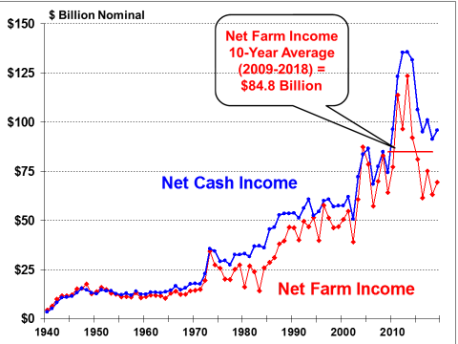 |
|
Source: ERS, "2019 Farm Income Forecast," March 6, 2019. All values are nominal—that is, not adjusted for inflation. Values for 2019 are forecasts. |
|
Figure 2. Annual U.S. Farm Sector Inflation-Adjusted Income, 1940-2019 |
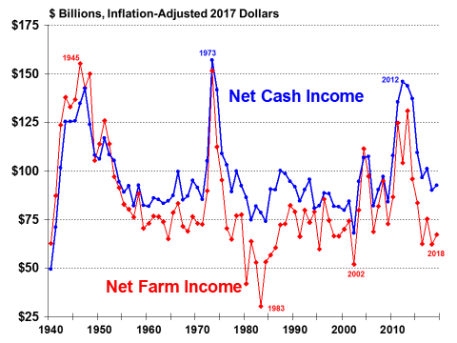 |
|
Source: ERS, "2019 Farm Income Forecast," March 6, 2019. All values are adjusted for inflation using the chain-type gross domestic product deflator, where 2017 = 100. Office of Management and Budget, Historical Tables, Table 10.1, https://www.whitehouse.gov/omb/budget/Historicals; 2019 is forecast. |
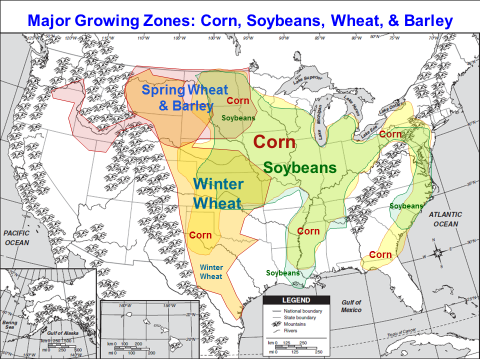 |
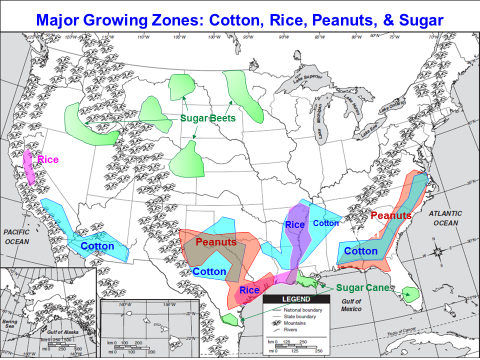 |
|
Source: Compiled by CRS based on USDA, Office of the Chief Economist, "Major World Crop Areas: North America," https://www.usda.gov/oce/weather/pubs/Other/MWCACP/namerica.htm. Note: In the upper figure, corn zones are yellow, soybeans are green, winter wheat is brown, and spring wheat and barley are pink. In the lower figure, cotton zones are blue, rice is pink, peanuts are brown, and sugar crops are green. Additional minor production activity occurs outside of the indicated zones. See source for mappings of minor production activity. |
U.S. Agriculture Outlook: 2019 Overview
Farm production choices in 2019 will largely be determined by producers' expectations for relative net returns from both the market and government programs across the various crops and livestock activities. Growing-season weather, yields, and harvest-time market prices are unknown early in the year when producers must lock in their production decisions for the year.
Heading into 2019, most of the major growing zones (Figure 3) across the Corn Belt, Plain States, Delta, and Southeast are largely free of drought (Figure 4). Some dryness persists primarily in the mountain states, the Pacific Northwest, and southern Texas.
Instead of dryness, excessive precipitation and early spring flooding present potential hindrances to the normal crop-choice and planting routines for 2019, particularly in the western Corn Belt (Figure 5).
|
Figure 4. Favorable Conditions Across Most Growing Zones Heading into 2019 |
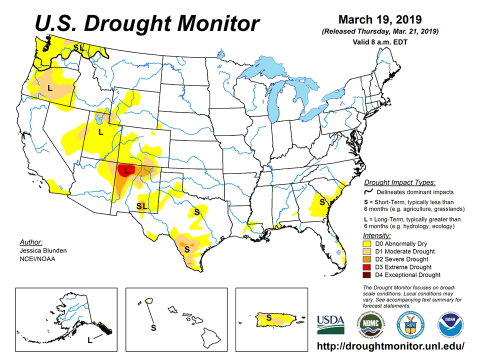 |
|
Source: USDA, Office of the Chief Economist, Current U.S. Drought Monitor, March 5, 2019, http://droughtmonitor.unl.edu/data/jpg/current/current_usdm.jpg. |
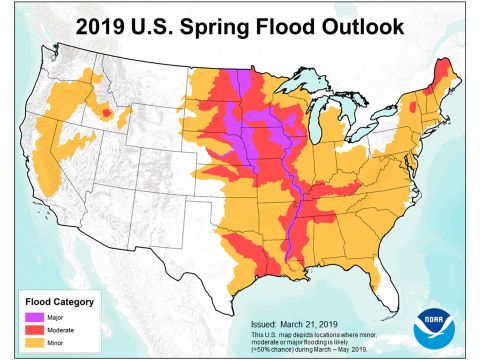 |
|
Source: National Oceanic and Atmospheric Administration, March 21, 2019. |
Large Corn and Soybean Crops Continue to Dominate Commodity Markets
Corn and soybeans are the two largest U.S. commercial crops in terms of both value and acreage. For the past several years, U.S. corn and soybean crops have experienced strong growth in both productivity and output, thus helping to build stockpiles at the end of the marketing year. This has been particularly true for soybeans, which have seen rapid growth in yield, acres planted, and stocks. This pattern reached a historic point in 2018 when, for the first time in history, U.S. soybean plantings (at 89.196 million acres) narrowly exceeded corn plantings (89.120 million acres). The record soybean plantings, coupled with the second-highest yields on record (51.6 bushels/acres), produced a record U.S. soybean harvest of 4.5 billion bushels and record ending stocks (900 million bushels) in 2018.6 The record harvest and abundant supply, coupled with the sudden loss of China as the principal buyer of U.S. soybeans in 2018, have pressured soybean farm prices lower (-8%) to a projected $8.60/bushel for the 2018/2019 marketing year—the lowest farm price since 2006 (Figure 6).7
Like soybeans, USDA estimated the second-highest corn yields on record in 2018 at 176.4 bushels/acre (just behind the previous year's record yield of 176.6 bushels/acre). As a result, the United States produced the third-largest corn harvest on record at 14.4 billion bushels. Despite the near-record production, USDA predicts that record large domestic usage (including for livestock feed, ethanol production, other industrial processing, and seed) plus large exports will result in a small reduction in corn ending stocks, a decline in the ending stocks-to-use ratio to 14.0% (down from 14.5%) and a slightly higher season average farm price of $3.55/bushel.
Both wheat and upland cotton farm prices are projected up slightly from 2017 despite relatively abundant stocks-to-use ratios, largely on the strength of international demand.
The corn and soybean crops provide important inputs for the domestic livestock, poultry, and biofuels sectors. In addition, the United States is traditionally one of the world's leading exporters of corn, soybeans, and soybean products—vegetable oil and meal. During the recent five-year period from 2013/2014 to 2017/2018, the United States exported 49% of its soybean production and 15% of its corn crop. As a result, the export outlook for these two crops is critical to both farm sector profitability and regional economic activity across large swaths of the United States as well as in international markets. However, a tariff-related trade dispute between the United States and several major trading partners (in particular, China) has cast uncertainty over the corn and soybean markets.8
The trade dispute has resulted in lower purchases of U.S. agricultural products by China in 2018,9 with continued diminished prospects for 2019. China was the top export market for U.S. agricultural products in 2017 with $25.9 billion in purchases. With the realization of diminished Chinese purchases, USDA has revised downward its expected export value to China for 2018 to $20.5 billion and for 2019 to $13.6 billion.10 Similarly, USDA has lowered its U.S. soybean export forecast from its initial estimate of 2.3 billion bushels in May 2018 to 1.875 billion bushels in its March 8, 2019, World Agricultural Supply and Demand Estimates report. The marketing year for corn and soybeans extends through August 2019. Thus, these forecasts depend on whether the trade dispute continues unabated or how the terms of any resolution (if one were to occur) would impact trade in the remaining months of the marketing year in 2019.
The rapid expansion of U.S. soybean production has come largely at the expense of the wheat sector, which has been steadily losing acreage over the past several decades (Figure 7). In 2017 U.S. wheat-planted acres were the lowest in over 100 years. Poor planting conditions in the fall of 2018 (for the 2019 winter wheat crop) across several states have resulted in the lowest estimated plantings outlook for winter wheat since 1909. The contraction in area is expected to support wheat prices and possibly lead to expanded spring wheat plantings in the Northern Plains in 2019.11
|
Figure 7. Planted Acres Since 1970: Corn, Soybeans, and Wheat |
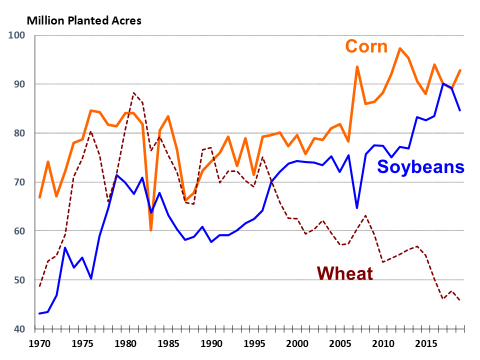 |
|
Source: USDA, National Agricultural Statistics Service (NASS). |
Livestock Outlook for 2019
USDA's February 2019 Cattle report reported that U.S. cattle herd expansion, which has been growing since 2015, has slowed markedly but is still projected to grow through 2019.12 Similarly, U.S. hog and poultry flocks have been growing and are expected to continue to expand in 2019.13 A key uncertainty for the meat-producing sector is whether demand will expand rapidly enough to absorb the continued growth in output or whether surplus production will begin to pressure prices lower. For 2019, expected production of beef (+1.6%), pork (+4.2%), broilers (+1.2%), and eggs (+2.3%) are projected to expand relatively robustly. This growth in protein production was preceded by strong growth rates in 2018: beef (+2.6%), pork (+2.9%), broilers (+2.2%), and eggs (+2.1%). USDA projects that combined domestic and export demand will continue to grow for red meat (+1.7%) and poultry (+0.9%) but at slower rates than projected meat production, thus contributing to the outlook for lower prices and profit margins for livestock in 2019.
Feed Margins Signal Profit Outlook
The changing conditions for the U.S. livestock sector may be tracked by the evolution of the ratios of livestock output prices to feed costs (Figure 10). A higher ratio suggests greater profitability for producers.14 The cattle-, hog-, and broiler-to-feed margins all moved upward in during 2014 but have exhibited volatility during the 2015-2018 period.15 The hog, cattle, and broiler sectors remain profitable. However, continued production growth of between 2% and 4% for red meat and poultry suggests that prices are vulnerable to weakness in demand. Both the milk- and hog-to-feed ratios fell during 2018, suggesting eroding profitability. While this result varies widely across the United States, many small or marginally profitable hog and milk producers face continued financial difficulties. In addition, both U.S. and global milk production are projected to continue growing in 2019. As a result, milk prices could come under further pressure in 2019, although USDA is currently projecting milk prices up slightly in 2019.16
Background on the U.S. Cattle-Beef Sector
Record profitability among cow-calf producers in 2014, coupled with then-improved forage conditions, helped to trigger the beef cow herd expansion (Figure 9).17 The continued cattle expansion through 2019—despite weakening profitability—is primarily the result of a lag in the biological response to the strong market price signals of late 2014. During the 2007-2014 period, high feed and forage prices plus widespread drought in the Southern Plains—the largest U.S. cattle production region—had resulted in an 8% contraction of the U.S. cattle inventory (Figure 9). Reduced beef supplies led to higher producer and consumer prices, which in turn triggered the slow rebuilding phase in the cattle cycle that started in 2014 (see the price-to-feed ratio for steers and heifers, Figure 10). The resulting continued expansion of beef supplies pressured market prices lower in 2016. The lower price outlook is expected to persist through 2019 despite strong domestic and international demand across all meat categories—beef, pork, and poultry (Table A-4).
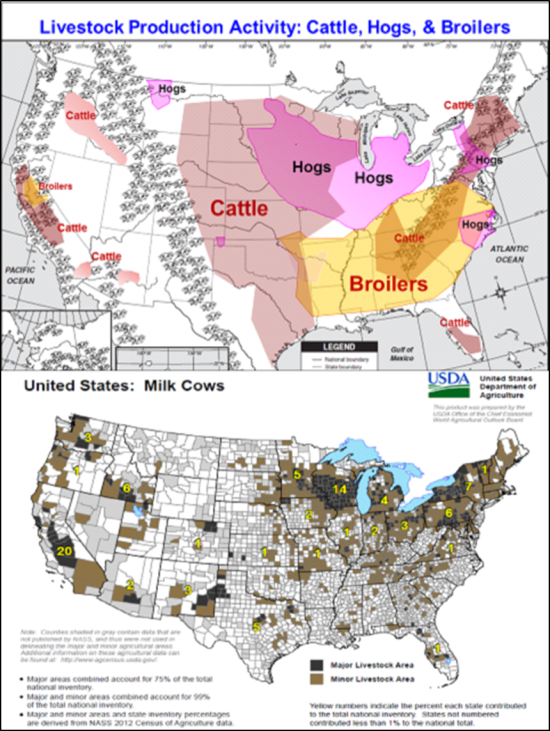 |
|
Source: Compiled by CRS based on USDA, Office of the Chief Economist, "Major World Crop Areas: North America," https://www.usda.gov/oce/weather/pubs/Other/MWCACP/namerica.htm. Notes: In the upper figure, cattle zones are purple, hogs are pink, and broilers are orange. In the lower figure, dairy zones are marked by light and dark shades of brown. Additional minor production activity occurs outside of the indicated zones. See source for mappings of minor production activity. |
|
Figure 9. The U.S. Beef Cattle Inventory (Including Calves) Since 1960 |
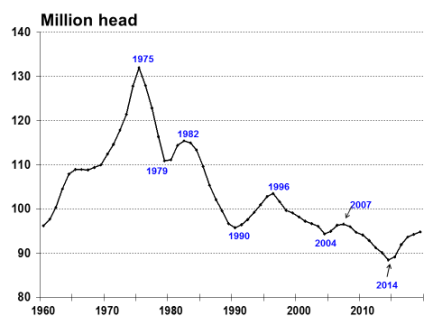 |
|
Source: NASS, Cattle, February 28, 2019. Notes: Inventory data are for January 1 of each year. |
Gross Cash Income Highlights
Projected farm-sector revenue sources in 2019 include crop revenues (47% of sector revenues), livestock receipts (42%), government payments (3%), and other farm-related income (8%), including crop insurance indemnities, machine hire, and custom work. Total farm sector gross cash income for 2019 is projected to be up (+1.4%) to $427.5 billion, driven by increases in both crop (+2%) and livestock (+2.6%) receipts (Figure 11). Cash receipts from direct government payments (-17%) and other farm-related income (-1.2) are down slightly from 2018.
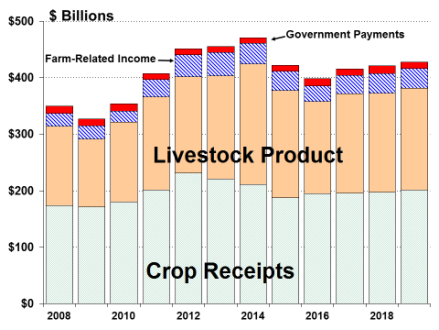 |
|
Source: ERS, "2019 Farm Income Forecast," March 6, 2019. All values are nominal—that is, not adjusted for inflation. Values for 2019 are forecasts. Notes: Farm-related income includes income from custom work, machine hire, agro-tourism, forest product sales, crop insurance indemnities, and cooperative patronage dividend fees. |
Crop Receipts
Total crop sales peaked in 2012 at $231.6 billion when a nationwide drought pushed commodity prices to record or near-record levels. In 2019, crop sales are projected at $201.7 billion, up slightly from 2018 (Figure 12). Projections for 2019 and percentage changes from 2018 include:
- Feed crops—corn, barley, oats, sorghum, and hay: $58.8 billion (+4.0%);
- Oil crops—soybeans, peanuts, and other oilseeds: $39.5 billion (-6.6%);
- Fruits and nuts: $32.9 billion (+8.2%);
- Vegetables and melons: $18.6 billion (+0.9%);
- Food grains—wheat and rice: $12.4 billion (+6.2%);
- Cotton: $8.3 billion (+6.5%); and
- Other crops including tobacco, sugar, greenhouse, and nursery: $29.8 billion (+2%).
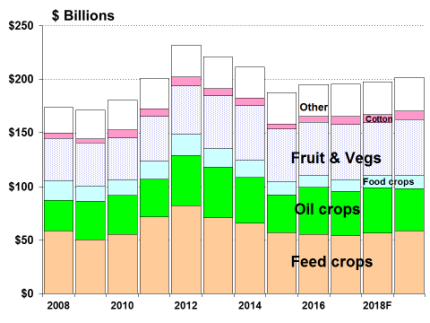 |
|
Source: ERS, "2019 Farm Income Forecast," March 6, 2019. All values are nominal—that is, not adjusted for inflation. Values for 2019 are forecasts. |
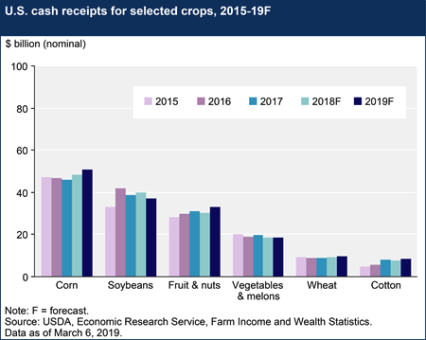 |
|
Source: ERS, "2019 Farm Income Forecast," March 6, 2019. All values are nominal—that is, not adjusted for inflation. Values for 2019 are forecasts. |
Livestock Receipts
The livestock sector includes cattle, hogs, sheep, poultry and eggs, dairy, and other minor activities. Cash receipts for the livestock sector grew steadily from 2009 to 2014, when it peaked at a record $212.8 billion. However, the sector turned downward in 2015 (-11.0%) and again in 2016 (-14.1%), driven largely by projected year-over-year price declines across major livestock categories (Table A-4 and Figure 14). In 2017, livestock sector cash receipts recovered with year-to-year growth of 8.1% to $176.0 billion. In 2018, cash receipts were nearly unchanged. In 2019, cash receipts are projected up 2.6% for the sector at $179.9 billion as cattle and dairy sales partially offset declines in hog and poultry. Projections for 2019 (and percentage changes from 2018) include:
- Cattle and calf sales: $69.2 billion (+4.0%);
- Poultry and egg sales: $46.0 billion (-0.7%);
- Dairy sales, valued at $37.8 billion (+7.8%);
- Hog sales: $19.5 billion (-3.2%); and
- Miscellaneous livestock,18 valued at $7.4 billion (+2.7%).
Government Payments
Government payments include direct payments (decoupled payments based on historical planted acres), price-contingent payments (program outlays linked to market conditions), conservation payments (including the Conservation Reserve Program and other environmental-based outlays), ad hoc and emergency disaster assistance payments (including emergency supplemental crop and livestock disaster payments and market loss assistance payments for relief of low commodity prices), and other miscellaneous outlays (including market facilitation payments, cotton ginning cost-share, biomass crop assistance program, peanut quota buyout, milk income loss, tobacco transition, and other miscellaneous payments).
Total government payments of $11.5 billion still represent a relatively small share (3%) of projected gross cash income of $427.5 billion in 2019. In contrast, government payments are expected to represent 16% of the projected net farm income of $69.4 billion. However, the importance of government payments as a percentage of net farm income varies nationally by crop and livestock sector and by region.
Government payments in 2019 are projected down 16.8% from 2018 at $11.5 billion (Figure 16 and Table A-4). Government payments in 2018 were inflated by unexpected payments of approximately $5.2 billion under the MFP initiated by USDA in response to the U.S.-China trade dispute.19 MFP payments to qualifying agricultural producers were estimated at $5.7 billion in 2018 and are projected at $3.5 billion in 2019, thus accounting for a year-to-year difference of -$2.2 billion. USDA ad hoc disaster assistance,20 at $1.4 billion, is projected up (+20.4%). MFP and ad hoc disaster assistance payments are expected to add $6.8 billion, or about 12%, to net farm income in 2018 and $4.9 billion, or about 8%, to net farm income in 2019.
Payments under the Agricultural Risk Coverage and Price Loss Coverage programs are projected lower in 2019 at $1.7 billion compared with an estimated $3.0 billion in 2018 (see "Price Contingent" in Figure 16).21 No payments are forecast under the marketing loan program in 2019, the same as in 2018, as program crop prices are expected to remain above most farm-bill loan rates through 2019. The new Dairy Margin Coverage program is expected to make $600 million in payments in 2019, up from $188 million under the previous milk Margin Protection Program (MPP) in 2018 (see next section for details).
Conservation programs include all conservation programs operated by USDA's Farm Service Agency and the Natural Resources Conservation Service that provide direct payments to producers. Estimated conservation payments of $4.3 billion are forecast for 2019, up slightly from $4.0 billion in 2018.
Dairy Margin Coverage Program Outlook
The 2018 farm bill (Agricultural Improvement Act of 2018, P.L. 115-334) made several changes to the previous MPP program, including a new name—the Dairy Margin Coverage (DMC) program—and expanded margin coverage choices from the original range of $4.00-$8.00 per hundredweight (cwt.).22 Under the 2018 farm bill, milk producers have the option of covering the milk-to-feed margin at a $9.50/cwt. threshold on the first 5 million pounds of milk coverage under the program.
|
Figure 17. The Dairy Output-to-Input Margin Has Fallen Below $8/cwt. in Early 2018 (The dairy margin equals the national average farm price of milk less average feed costs per 100 lbs.) |
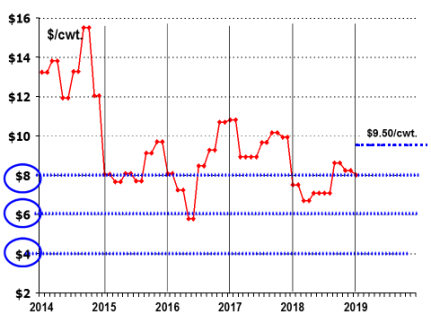 |
|
Source: NASS, Agricultural Prices, February 28, 2019; calculations by CRS. All values are nominal. Note: The margin equals the All Milk price minus a composite feed price based on the formula used by the DMC of the 2018 farm bill starting January 2019 and, for all prior months, the MPP of the 2014 farm bill (P.L. 113-79). See CRS Report R45525, The 2018 Farm Bill (P.L. 115-334): Summary and Side-by-Side Comparison. |
The DMC margin differs from the USDA-reported milk-to-feed ratio shown in Figure 10 but reflects the same market forces. As of January 2019, the formula-based milk-to-feed margin used to determine government payments was below the newly instituted $9.50/cwt. threshold (Figure 17), thus increasing the likelihood of DMC payments in 2019.
Production Expenses
Total production expenses for 2019 for the U.S. agricultural sector are projected to be up slightly (+0.6%) from 2018 in nominal dollars at $372.0 billion (Figure 18). Production expenses peaked in both nominal and inflation-adjusted dollars in 2014, then declined for two years before resuming their upward trend in nominal dollars in 2017.
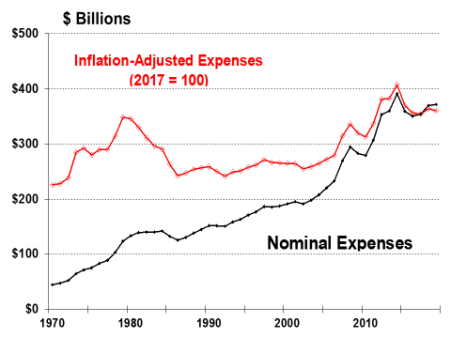 |
|
Source: ERS, "2019 Farm Income Forecast," March 6, 2019. All values are nominal—that is, not adjusted for inflation. Inflation-adjusted expenses are calculated using the chain-type GDP deflator. OMB, Historical Tables, Table 10.1. Amounts for 2019 are forecasts. |
But how have production expenses moved relative to revenues? A comparison of the indexes of prices paid (an indicator of expenses) versus prices received (an indicator of revenues) reveals that the prices received index generally declined from 2014 through 2016, rebounded in 2017, then declined again in 2018 (Figure 19). Farm input prices (as reflected by the prices paid index) showed a similar pattern but with a much smaller decline from their 2014 peak, thus suggesting that farm sector profit margins have been squeezed since 2014.
Production expenses will affect crop and livestock farms differently. The principal expenses for livestock farms are feed costs, purchases of feeder animals and poultry, and hired labor. Feed costs, labor expenses, interest costs, and property taxes are all projected up in 2019 (Figure 20). In contrast, fuel, land rent, and fertilizer costs are projected lower.
Cash Rental Rates
Renting or leasing land is a way for young or beginning farmers to enter agriculture without incurring debt associated with land purchases. It is also a means for existing farm operations to adjust production more quickly in response to changing market and production conditions while avoiding risks associated with land ownership. The share of rented farmland varies widely by region and production activity. However, for some farms it constitutes an important component of farm operating expenses. Since 2002, about 38% of agricultural land used in U.S. farming operations has been rented.23
The majority of rented land in farms is rented from nonoperating landlords. Nationally in 2012, 30% of all land in farms was rented from someone other than a farm operator. Some farmland is rented from other farm operations—nationally about 8% of all land in farms in 2012 (the most recent year for which data are available)—and thus constitutes a source of income for some operator landlords. Total net rent to nonoperator landlords is projected to be down (-2.1%) at $14.3 billion in 2019.
Cash rental rates for 2019 are not yet available. Average cash rental rates for 2018 were up year-over-year ($138 per acre versus $136 in 2017). Although rental rates—which for 2019 were set the preceding fall of 2018 or in early spring of 2019—dipped in 2016, they still reflect the high crop prices and large net returns of the preceding several years, especially the 2011-2014 period (Figure 21). The national rental rate for cropland peaked at $144 per acre in 2015.24
|
Figure 21. U.S. Average Farmland Cash Rental Rates Since 1998 |
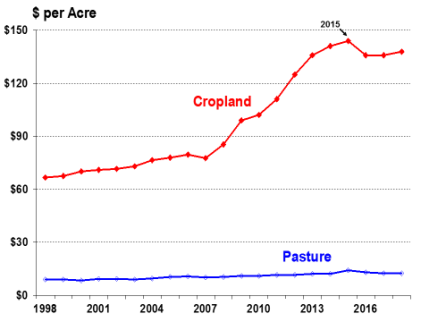 |
|
Source: NASS, Agricultural Land Values, August 2, 2018. All values are nominal. |
Agricultural Trade Outlook
U.S. agricultural exports have been a major contributor to farm income, especially since 2005. As a result, the downturn in those exports that started in 2015 (Figure 22) deepened the downturn in farm income that had started in 2013 (Figure 1).
Key U.S. Agricultural Trade Highlights
- USDA projects U.S. agricultural exports at $141.5 billion in FY2019, down slightly (-1%) from $143.4 billion in FY2018. Export data include processed and unprocessed agricultural products. This downturn masks larger country-level changes that have occurred as a result of ongoing trade disputes (as discussed below).
- In FY2019, U.S. agricultural imports are projected nearly unchanged at $127.0 billion, but the resultant agricultural trade surplus of $14.5 billion would be the lowest since 2007.
|
Figure 22. U.S. Agricultural Trade Since 2005, Nominal Values |
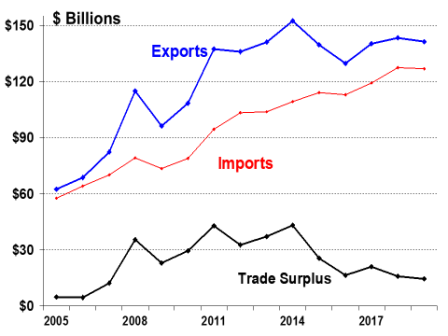 |
|
Source: ERS, Outlook for U.S. Agricultural Trade, AES-107, February 21, 2019. Amounts for 2018 and 2019 are projected. |
- A substantial portion of the surge in U.S. agricultural exports that occurred between 2010 and 2014 was due to higher-priced grain and feed shipments, including record oilseed exports to China and growing animal product exports to East Asia. As commodity prices have leveled off, so too have export values (see the commodity price indexes in Figure A-1 and Figure A-2).
- In FY2017, the top three markets for U.S. agricultural exports were China, Canada, and Mexico, in that order. Together, these three countries accounted for 46% of total U.S. agricultural exports during the five-year period FY2014-FY2018 (Figure 23).
- However, in FY2019 the combined share of U.S. exports taken by China, Canada, and Mexico is projected down to 42% largely due to sharply lower exports to China. The ordering of the top three markets is reordered to Canada, Mexico, and China, as China is projected to barely stay ahead of the European Union and Japan as a destination for U.S. agricultural exports.
- From FY2014 through FY2017, China imported an average of $26.2 billion of U.S. agricultural products. However, USDA forecasts China's imports of U.S. agricultural products to decline to $20.5 billion in FY2018 and to $13.6 billion in FY2019 as a result of the U.S.-China trade dispute.
- The fourth- and fifth-largest U.S. export markets are the European Union and Japan, which have accounted for a combined 17% of U.S. agricultural exports during the FY2014-FY2018 period. This same share is projected to continue in FY2019 (Figure 23). These two markets have shown relatively limited growth in recent years when compared with the rest of the world.
|
Figure 23. U.S. Agricultural Exports Have Leveled Off Since FY2011 (Inflation adjusted using the implicit chain GDP deflator, 2017 = 100) |
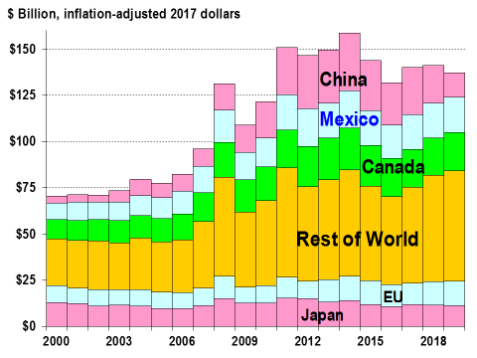 |
|
Source: ERS, Outlook for U.S. Agricultural Trade, AES-107, February 21, 2019. Amounts for 2018 and 2019 are projected. All values are adjusted for inflation by CRS using the chain-type gross domestic product deflator, where 2017 = 100. OMB, Historical Tables, Table 10.1, https://www.whitehouse.gov/omb/budget/Historicals. Note: Data are for fiscal years (October to September). |
- The "Rest of World" (ROW) component of U.S. agricultural trade—South and Central America, the Middle East, Africa, and Southeast Asia—has shown strong import growth in recent years. ROW is expected to account for 41% of U.S. agricultural exports in FY2019. ROW import growth is being driven in part by both population and GDP growth but also from shifting trade patterns as some products previously targeting China have been diverted to new markets.
- Over the past four decades, U.S. agricultural exports have experienced fairly steady growth in shipments of high-value products—including horticultural products, livestock, poultry, and dairy. High-valued exports are forecast at $94.3 billion for a 66.6% share of U.S. agricultural exports in FY2019 (Figure 24).
- In contrast, bulk commodity shipments (primarily wheat, rice, feed grains, soybeans, cotton, and unmanufactured tobacco) are forecast at a 33.4% share of total U.S. agricultural exports in FY2019 at $47.2 billion. This compares with an average share of over 60% during the 1970s and into the 1980s. As grain and oilseed prices decline, so will the bulk value share of U.S. exports.
|
Figure 24. U.S. Agricultural Trade: Bulk vs. High-Value Shares |
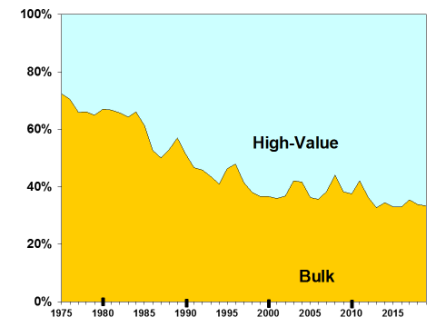 |
|
Source: ERS, Outlook for U.S. Agricultural Trade, AES-107, February 21, 2019. Amounts for 2018 and 2019 are projected. |
U.S. Farm and Manufactured Agricultural Product Export Shares
The share of agricultural production (based on value) sold outside the country indicates the level of U.S. agriculture's dependence on foreign markets, as well as the overall market for U.S. agricultural products.
|
The U.S. Export Share Measurement for Agriculture Because agricultural and food exports consist of farm commodities and their manufactured products, a substantial component of export value represents value-added from marketing and processing. This value-added must be accounted for in measuring the U.S. export share. With this in mind, ERS calculates the export value share for agriculture as follows:25 The numerator includes aggregated export values for all agricultural products—including bulk commodities and manufactured products. The denominator includes the total value of U.S. farm and manufactured agricultural production—estimated as farm cash receipts for crop and livestock production plus the value added by agricultural manufacturers. The value-added amount for agricultural processing is from the U.S. Census Bureau's Annual Survey of Manufacturers. |
As a share of total farm and manufactured agricultural production, U.S. exports were estimated to account for 19.8% of the overall market for agricultural products from 2008 through 2016—the most recent data year for this calculation (Figure 25). The export share of agricultural production varies by product category.
- At the upper end of the range for export shares, the bulk food grain export share has varied between 50% and 80% since 2008, while the oilseed export share has ranged between 47% and 58%.
- The mid-spectrum range of export shares includes the export share for fruit and tree nuts, which has ranged from 37% to 45%, while meat products have ranged from 27% to 41%.
- At the low end of the spectrum, the export share of vegetable and melon sales has ranged from 15% to 18%, the dairy products export share from 9% to 24%, and the agricultural-based beverage export share between 7% and 13%.
Farm Asset Values and Debt
The U.S. farm income and asset-value situation and outlook suggest a relatively stable financial position heading into 2019 for the agriculture sector as a whole—but with considerable uncertainty regarding the downward outlook for prices and market conditions for the sector and an increasing dependency on international markets to absorb domestic surpluses
- Farm asset values—which reflect farm investors' and lenders' expectations about long-term profitability of farm sector investments—are projected to be up 1.5% in 2019 to a nominal $3.1 trillion (Table A-3). In inflation-adjusted terms (using 2017 dollars), farm asset values peaked in 2014 (Figure 26).
- Nominally higher farm asset values are expected in 2019 due to higher real estate values (+1.8%), which offset a slight decrease in nonreal estate values (-0.1%). Real estate is projected to account for 83% of total farm sector asset value.
- Crop land values are closely linked to commodity prices. The leveling off of crop land values since 2015 reflects mixed forecasts for commodity prices (corn, soybeans, and cotton lower; wheat, rice, and livestock products higher) and the uncertainty associated with international commodity markets (Figure 27).
- Total farm debt is forecast to rise to a record $426.7 billion in 2019 (+3.9%) (Table A-3). Farm equity—or net worth, defined as asset value minus debt—is projected to be up slightly (+1.1%) at $2.7 trillion in 2019 (Table A-3).
- The farm debt-to-asset ratio is forecast up in 2019 at 13.9%, the highest level since 2002 but still relatively low by historical standards (Figure 28).
|
Measuring Farm Wealth: The Debt-to-Asset Ratio A useful measure of the farm sector's financial well-being is net worth as measured by farm assets minus farm debt. A summary statistic that captures this relationship is the debt-to-asset ratio. Farm assets include both physical and financial farm assets. Physical assets include land, buildings, farm equipment, on-farm inventories of crops and livestock, and other miscellaneous farm assets. Financial assets include cash, bank accounts, and investments such as stocks and bonds. Farm debt includes both business and consumer debt linked to real estate and nonreal-estate assets (e.g., financial assets, inventories of agricultural products, and the value of machinery and motor vehicles) of the farm sector. The debt-to-asset ratio compares the farm sector's outstanding debt related to farm operations relative to the value of the sector's aggregate assets. Change in the debt-to-asset ratio is a critical barometer of the farm sector's financial performance, with lower ratios indicating greater financial resiliency. A lower debt-to-asset ratio suggests that the sector is better able to withstand short-term increases in debt related to interest rate fluctuations or changes in the revenue stream related to lower output prices, higher input prices, or production shortfalls. The largest single component in a typical farmer's investment portfolio is farmland. As a result, real estate values affect the financial well-being of agricultural producers and serve as the principal source of collateral for farm loans. |
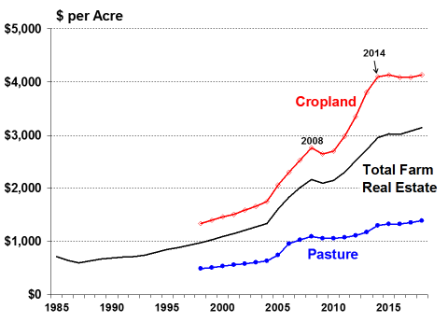 |
|
Source: NASS, Land Values 2018 Summary, August 2018. Notes: Farm real estate value measures the value of all land and buildings on farms. Separate cropland and pasture values are available only since 1998. All values are nominal. |
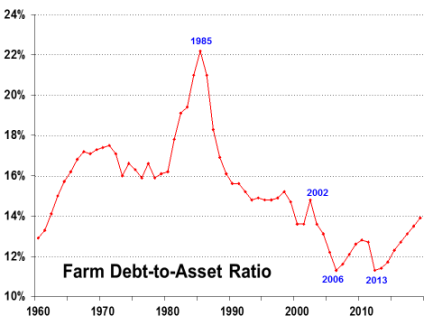 |
|
Source: ERS, "2019 Farm Income Forecast," March 6, 2019. Values for 2019 are forecasts. |
Average Farm Household Income
A farm can have both an on-farm and an off-farm component to its income statement and balance sheet of assets and debt.26 Thus, the well-being of farm operator households is not equivalent to the financial performance of the farm sector or of farm businesses because of the inclusion of nonfarm investments, jobs, and other links to the nonfarm economy.
- Average farm household income (sum of on- and off-farm income) is projected at $115,588 in 2019 (Table A-2), up 4.3% from 2018 and below the record of $134,164 in 2014.
- About 18% ($20,365) of total farm household income is from farm production activities, and the remaining 82% ($95,223) is earned off the farm (including financial investments).
- The share of farm income derived from off-farm sources had increased steadily for decades but peaked at about 95% in 2000 (Figure 29).
Total vs. Farm Household Average Income
- Since the late 1990s, farm household incomes have surged ahead of average U.S. household incomes (Figure 30).
- In 2017 (the last year for which comparable data were available), the average farm household income of $113,495 was about 32% higher than the average U.S. household income of $86,220 (Table A-2).
Appendix. Supporting Charts and Tables
Figure A-1 to Figure A-4 present USDA data on monthly farm prices received for several major farm commodities—corn, soybeans, wheat, upland cotton, rice, milk, cattle, hogs, and chickens. The data are presented in an indexed format where monthly price data for year 2010 = 100 to facilitate comparisons.
Table A-1 to Table A-3 present aggregate farm income variables that summarize the financial situation of U.S. agriculture. In addition, Table A-4 presents the annual average farm price received for several major commodities, including the USDA forecast for the 2018-2019 marketing year.
|
Item |
2012 |
2013 |
2014 |
2015 |
2016 |
2017 |
2018 |
2019a |
Change (%)a |
||||||||||||||||||
|
1. Cash receipts |
|
|
|
|
|
|
|
|
|
||||||||||||||||||
|
Cropsb |
|
|
|
|
|
|
|
|
|
||||||||||||||||||
|
Livestock |
|
|
|
|
|
|
|
|
|
||||||||||||||||||
|
2. Government paymentsc |
|
|
|
|
|
|
|
|
|
||||||||||||||||||
|
Fixed direct paymentsd |
|
|
|
|
|
|
|
|
|
||||||||||||||||||
|
CCP-PLC-ARCe |
|
|
|
|
|
|
|
|
|
||||||||||||||||||
|
Marketing loan benefitsf |
|
|
|
|
|
|
|
|
|
||||||||||||||||||
|
Conservation |
|
|
|
|
|
|
|
|
|
||||||||||||||||||
|
Ad hoc and emergencyg |
|
|
|
|
|
|
|
|
|
||||||||||||||||||
|
All otherh |
|
|
|
|
|
|
|
|
|
||||||||||||||||||
|
3. Farm-related incomei |
|
|
|
|
|
|
|
|
|
||||||||||||||||||
|
4. Gross cash income (1+2+3) |
|
|
|
|
|
|
|
|
|
||||||||||||||||||
|
5. Cash expensesj |
|
|
|
|
|
|
|
|
|
||||||||||||||||||
|
6. NET CASH INCOME |
|
|
|
|
|
|
|
|
|
||||||||||||||||||
|
7. Total gross revenuesk |
|
|
|
|
|
|
|
|
|
||||||||||||||||||
|
8. Total production expensesl |
|
|
|
|
|
|
|
|
|
||||||||||||||||||
|
9. NET FARM INCOME |
|
|
|
|
|
|
|
|
|
Source: ERS, Farm Income and Wealth Statistics; U.S. and State Farm Income and Wealth Statistics, updated as of March 6, 2019. NA = not applicable.
a. Data for 2019 are USDA forecasts. Change represents year-to-year projected change between 2018 and 2019.
b. Includes Commodity Credit Corporation loans under the farm commodity support program.
c. Government payments reflect payments made directly to all recipients in the farm sector, including landlords. The nonoperator landlords' share is offset by its inclusion in rental expenses paid to these landlords and thus is not reflected in net farm income or net cash income.
d. Direct payments include production flexibility payments of the 1996 Farm Act through 2001 and fixed direct payments under the 2002 Farm Act since 2002.
e. CCP = counter-cyclical payments. PLC = Price Loss Coverage. ARC = Agricultural Risk Coverage.
f. Includes loan deficiency payments, marketing loan gains, and commodity certificate exchange gains.
g. Includes payments made under the Average Crop Revenue Election program, which was eliminated by the 2014 farm bill (P.L. 113-79).
h. Market facilitation payments, cotton ginning cost-share, biomass crop assistance program, milk income loss, tobacco transition, and other miscellaneous payments.
i. Income from custom work, machine hire, agri-tourism, forest product sales, and other farm sources.
j. Excludes depreciation and perquisites to hired labor.
k. Gross cash income plus inventory adjustments, the value of home consumption, and the imputed rental value of operator dwellings.
l. Cash expense plus depreciation and perquisites to hired labor.
|
2012 |
2013 |
2014 |
2015 |
2016 |
2017 |
2018 |
2019 |
|||||||||
|
Average U.S. farm income by source |
|
|
|
|
|
|
|
|
||||||||
|
On-farm income |
|
|
|
|
|
|
|
|
||||||||
|
Off-farm income |
|
|
|
|
|
|
|
|
||||||||
|
Total farm income |
|
|
|
|
|
|
|
|
||||||||
|
Average U.S. household income |
|
|
|
|
|
|
NA |
NA |
||||||||
|
Farm household income as share of U.S. avg. household income (%) |
156% |
|
177% |
151% |
142% |
132% |
NA |
NA |
Source: ERS, Farm Household Income and Characteristics, principal farm operator household finances, data set updated as of March 6, 2019, http://www.ers.usda.gov/data-products/farm-household-income-and-characteristics.aspx.
Note: NA = not available. Data for 2018 and 2019 are USDA forecasts.
|
2012 |
2013 |
2014 |
2015 |
2016 |
2017 |
2018 |
2019 |
|||||||||||||||||
|
Farm assets |
|
|
|
|
|
|
|
|
||||||||||||||||
|
Farm debt |
|
|
|
|
|
|
|
|
||||||||||||||||
|
Farm equity |
|
|
|
|
|
|
|
|
||||||||||||||||
|
Debt-to-asset ratio (%) |
|
|
|
|
|
|
|
|
Source: ERS, Farm Income and Wealth Statistics; U.S. and State Farm Income and Wealth Statistics, updated as of March 6, 2019, http://www.ers.usda.gov/data-products/farm-income-and-wealth-statistics.aspx.
Note: Data for 2018 and 2019 are USDA forecasts.
Table A-4. U.S. Farm Prices and Support Rates for Selected Commodities Since 2013-2014 Marketing Year
|
Commoditya |
Unit |
Year |
2013-2014 |
2014-2015 |
2015-2016 |
2016-2017 |
2017-2018 |
2018-2019b |
% Chgc 2017/18 to 2018/19 |
2019-2020b |
% Chgd 2018/19 to 2019/20 |
Loan Ratee |
Refer-ence Price |
||||||||||||
|
Wheat |
$/bu |
Jun-May |
|
|
|
|
|
5.15-5.25 |
10.2% |
— |
— |
3.38 |
5.50 |
||||||||||||
|
Corn |
$/bu |
Sep-Aug |
|
|
|
|
|
3.40-3.70 |
5.7% |
— |
— |
2.20 |
3.70 |
||||||||||||
|
Sorghum |
$/bu |
Sep-Aug |
|
|
|
|
|
3.05-3.35 |
-0.6% |
— |
— |
2.20 |
3.95 |
||||||||||||
|
Barley |
$/bu |
Jun-May |
|
|
|
|
|
4.40-4.80 |
2.9% |
— |
— |
2.50 |
4.95 |
||||||||||||
|
Oats |
$/bu |
Jun-May |
|
|
|
|
|
2.60-2.70 |
2.3% |
— |
— |
2.00 |
2.40 |
||||||||||||
|
Rice |
$/cwt |
Aug-Jul |
|
|
|
|
|
11.80-12.40 |
-6.2% |
— |
— |
7.00 |
14.00 |
||||||||||||
|
Soybeans |
$/bu |
Sep-Aug |
|
|
|
|
|
8.35-8.85 |
-7.8% |
— |
— |
6.20 |
8.40 |
||||||||||||
|
Soybean Oil |
¢/lb |
Oct-Sep |
|
|
|
|
|
28.00-30.00 |
-3.5% |
— |
— |
— |
— |
||||||||||||
|
Soybean Meal |
$/st |
Oct-Sep |
|
|
|
|
|
305-325 |
-8.7% |
— |
— |
— |
— |
||||||||||||
|
Cotton, Upland |
¢/lb |
Aug-Jul |
|
|
|
|
|
69-71 |
2.0% |
— |
— |
45-52 |
none |
||||||||||||
|
Choice Steers |
$/cwt |
Jan-Dec |
|
|
|
|
|
117.12 |
-3.6% |
117-122 |
2.0% |
— |
— |
||||||||||||
|
Barrows/Gilts |
$/cwt |
Jan-Dec |
|
|
|
|
|
45.93 |
-9.0% |
45-47 |
0.2% |
— |
— |
||||||||||||
|
Broilers |
¢/lb |
Jan-Dec |
|
|
|
|
|
97.8 |
4.6% |
94-98 |
-1.8% |
— |
— |
||||||||||||
|
Eggs |
¢/doz |
Jan-Dec |
|
|
|
|
|
137.6 |
36.4% |
103-108 |
-23.3% |
— |
— |
||||||||||||
|
Milk |
$/cwt |
Jan-Dec |
|
|
|
|
|
16.18 |
-8.3% |
17.25-17.75 |
8.2% |
— |
— |
||||||||||||
Source: Various USDA agency sources as described in the notes below.
Notes: bu = bushels, cwt = 100 pounds, lb = pound, st = short ton (2,000 pounds), doz = dozen.
a. Price for grains and oilseeds are from USDA, World Agricultural Supply and Demand Estimates (WASDE), April 8, 2019. Calendar year data are for the first year. For example, 2018-2019 = 2018. "—" = no value, and USDA's out-year 2019-2020 crop price forecasts will first appear in the May 2019 WASDE. Soybean and livestock product prices are from USDA, Agricultural Marketing Service: soybean oil—Decatur, IL, cash price, simple average crude; soybean meal—Decatur, IL, cash price, simple average 48% protein; choice steers—Nebraska, direct 1,100-1,300 lbs.; barrows/gilts—national base, live equivalent 51%-52% lean; broilers—wholesale, 12-city average; eggs—Grade A, New York, volume buyers; and milk—simple average of prices received by farmers for all milk.
b. Data for 2018-2019 are USDA forecasts. Data for 2019-2020 are USDA projections.
c. Percentage change for 2017/18 to 2018/19, calculated using difference from the midpoint of the range for 2018-2019 with estimate for 2017-2018.
d. Percentage change for 2018/19 to 2019/20, calculated using difference from the midpoint of the range for 2019-2020 with midpoint of the range for 2018-2019.
e. Loan rate and reference prices are for the 2019-2020 market year as defined under the 2018 farm bill (P.L. 115-334). The loan rate for upland cotton equals the average market-year-average price for the two preceding crop years but within the range of 45 cents/lb. and 52 cents/lb. See CRS Report R45525, The 2018 Farm Bill (P.L. 115-334): Summary and Side-by-Side Comparison.
Author Contact Information
Footnotes
| 1. |
For both national and state-level farm income, see ERS, "U.S. and State Farm Income and Wealth Statistics," http://www.ers.usda.gov/data-products/farm-income-and-wealth-statistics.aspx. |
| 2. |
ERS, "Farm Structure and Organization," http://www.ers.usda.gov/topics/farm-economy/farm-structure-and-organization.aspx; and "Farm Household Well-Being," http://www.ers.usda.gov/topics/farm-economy/farm-household-well-being.aspx. |
| 3. |
ERS's first farm income forecast was released on March 6, 2019. ERS is to update its farm income outlook in August (mid-year outlook) and again in November. ERS's 2019 Farm Sector Income Forecasts are available at https://www.ers.usda.gov/topics/farm-economy/farm-sector-income-finances/farm-sector-income-forecast/. |
| 4. |
See CRS Report R45310, Farm Policy: USDA's Trade Aid Package. |
| 5. |
ERS, Outlook for U.S. Agricultural Trade, AES-106, November 29, 2018. |
| 6. |
USDA, World Agricultural Outlook Board (WAOB), World Agricultural Supply and Demand Estimates (WASDE), March 8, 2019. |
| 7. |
The marketing year varies slightly with each agricultural commodity, but it tends to begin at harvest and end before the next year's harvest. For example, the marketing year for corn planted and harvested in 2018 begins September 1, 2018, and ends August 31, 2019. |
| 8. |
See CRS Insight IN10943, Escalating Tariffs: Timeline; and CRS Insight IN10880, China's Retaliatory Tariffs on Selected U.S. Agricultural Products. |
| 9. |
See CRS Report R45310, Farm Policy: USDA's Trade Aid Package. |
| 10. |
ERS, Outlook for U.S. Agricultural Trade, AES-107, February 21, 2019. |
| 11. |
Rob Johansson, "The Outlook for U.S. Agriculture—2019," USDA, February 21, 2019. |
| 12. |
USDA, National Agricultural Statistics Service, Cattle, February 22, 2019. |
| 13. |
WAOB, WASDE, Table—U.S. Quarterly Animal Product Production, March 8, 2019, p. 31. |
| 14. |
Feed costs—at 30% to 80% of variable costs—are generally the largest cost component in livestock operations. |
| 15. |
Broilers are chickens raised for meat. Layers are chickens retained for egg production. |
| 16. |
WAOB, WASDE, Table—U.S. Quarterly Prices for Animal Products, November 8, 2018, p. 31. |
| 17. |
J. Mintert, "Cattle Inventory Growth Slowing Down, but Beef Production Still Increasing," farmdoc daily, vol. 8, no. 18 (February 5, 2018). |
| 18. |
Miscellaneous livestock includes aquaculture, sheep and lambs, honey, mohair, wool, pelts, and other animal products. |
| 19. |
In July 2018, USDA announced a trade aid package including up to $12 billion in financial support designed to partially offset the negative price and income effects of lost commodity sales to major markets. The trade aid package included direct payments of up to an estimated $9.7 billion to qualifying producers of soybeans, corn, cotton, sorghum, wheat, hogs, dairy, fresh sweet cherries, and shelled almonds. The trade aid package also included $1.2 billion in government purchases of excess food supplies and $200 million in trade promotion. See CRS Report R45310, Farm Policy: USDA's Trade Aid Package. |
| 20. |
Fiscal year payments generally involve outlay commitments incurred during the previous crop year. For example, FY2019 disaster assistance payments are primarily related to disasters for crops that were grown and harvested in 2018. See CRS Report RS21212, Agricultural Disaster Assistance, for information on available farm disaster programs. |
| 21. |
For details see CRS Report R43448, Farm Commodity Provisions in the 2014 Farm Bill (P.L. 113-79). |
| 22. |
The margin equals the All Milk price minus a composite feed price based on the formula used by the DMC of the 2018 farm bill starting January 2019 and, for all prior months, the MPP of the 2014 farm bill (P.L. 113-79). See CRS Report R45525, The 2018 Farm Bill (P.L. 115-334): Summary and Side-by-Side Comparison, and CRS In Focus IF10195, U.S. Dairy Programs After the 2014 Farm Bill (P.L. 113-79). |
| 23. |
ERS, "Land Use, Land Values and Tenure: Farmland Ownership and Tenure," https://www.ers.usda.gov/topics/farm-economy/land-use-land-value-tenure/farmland-ownership-and-tenure/. |
| 24. |
Local and regional land rental rates may vary substantially from the national average. |
| 25. |
The methodology is described at ERS, "U.S. Export Share of Production," https://www.ers.usda.gov/topics/international-markets-us-trade/us-agricultural-trade/. |
| 26. |
ERS, "Farm Household Well-Being," http://www.ers.usda.gov/topics/farm-economy/farm-household-well-being.aspx. |
